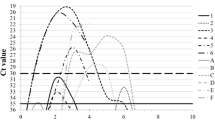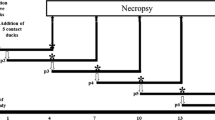Summary
Strains of an influenza H10N4 virus have been isolated during an outbreak of a respiratory disease in mink on the south-east coast of Sweden. This was the first example of a disease in mammals caused by the H10 subtype. We compared the A/mink/Sweden/84 strain with two recent avian H10N4 isolates, one from fowl and another from a mallard, both isolated in Great Britain in 1985 as well as the prototype A/chicken/Germany/N/49 (N10N7). The comparison was carried out by genomic analysis of the strains by oligonucleotide fingerprinting and in bioassays on mink. The oligonucleotide fingerprint analysis revealed a high degree of genomic homology of around 98% between the viruses from mink, mallard and fowl. Only the recent avian isolates, that from the mallard and fowl could infect mink by contact, causing similar pathological and clinical signs and inducing seroconversion as did the mink virus. However, the susceptibility of mink to the fowl and mallard viruses by contact was less pronounced than that to the mink virus. Both the genomic homology and the similarities from the infectivity and pathogenicity studies between the mink virus and the recent avian isolates point to a direct invasion of the mink population by an avian H10N4 virus.
Similar content being viewed by others
References
Aaronson RP, Young JF, Palese P (1982) Oligonucleotide mapping: evaluation of its sensitivity by computer-simulation. Nucleic Acids Res 10: 237–246
Abusugra IA, Linné T, Klingeborn B, Dinter Z (1985) Influenza equi 2: patterns of RNA and protein in variant strains. Zentralbl Veterinarmed [B] 32: 567–574
Alexander DJ, Gough RE (1986) Isolation of avian influenza virus from birds in Great Britain. Vet Rec 118: 537–538
Dinter Z (1949) Eine Variante des Virus der Geflügelpest in Bayern? Tierärztl Umschau 4: 185–186
Englund L, Klingeborn B, Mejerland T (1986) Avian influenza A virus causing an outbreak of contagious interstitial pneumonia in mink. Acta Vet Scand 27: 497–504
Feldmann H, Kretzschmar E, Klingeborn B, Rott R, Klenk H.-D, Garten W (1988) The structure of serotype H10 hemagglutinin of influenza A virus: comparison of an apathogenic avian and a mammalian strain pathogenic for mink. Virology 165: 428–437
Geraci JR, Aubin DJ, Barker IK, Webster RG, Hinshaw VS, Bean WJ, Ruhnke HL, Prescott JH, Early G, Baker AS, Madoff S, Schooley RT (1982) Mass mortality of harbour seals: pneumonia associated with influenza A virus. Science 215: 1129–1131
Hinshaw VS, Bean WJ, Webster RG, Rehg JE, Fiorelli P, Early G, Geraci JR, Aubin DJ (1984) Are seals frequently infected with avian influenza viruses. J Virol 51: 863–865
Hinshaw VS, Bean WJ, Geraci J, Fiorelli P, Early G, Webster RG (1986) Characterization of two influenza A viruses from a pilot whale. J Virol 58: 655–656
Karunakaran D, Hinshaw V, Poss P, Neuman J, Halvorsen D (1983) Influenza A outbreaks in Minnesota turkeys due to the subtype H10N7 and possible transmission by waterfowl. Avian Dis 27: 357–366
Kew OM, Nottay BK, Obijeski JF (1984) Applications of oligonucleotide fingerprinting to the identification of viruses. Methods Virol 8: 41–84
Klingeborn B, Englund L, Rott R, Juntti N, Rockborn G (1985) An avian influenza A virus killing a mammalian species-The mink. Arch Virol 86: 347–351
Lang G, Gagnon A, Gerachi JR (1981) Isolation of an influenza A virus from seals. Arch Virol 68: 189–195
Nakajima K, Desselberger U, Palese P (1978) Recent human influenza A (H1N1) viruses are closely related genetically to strains isolated in 1950. Nature 274: 334–339
Okazaki K, Yanagawa R, Kida H, Noda H (1983) Human influenza virus infection in mink: serological evidence of infection in summer and autumn. Vet Microbiol 8: 251–252
Okazaki K, Yanagawa R, Kida H (1983) Contact infection of mink with 5 subtypes of avian influenza virus. Arch Virol 77: 265–269
Otsuki K, Takemoto O, Fujimoto R, Yamazaki K, Kubota N, Hosaki H, Mitani T, Tsubokura M (1987) Isolation of influenza A viruses from migratory waterfowl in Sanin district, western Japan in the winter of 1983–1984. Res Vet Sci 43: 177–179
Pedersen FS, Haseltine WA (1980) A micromethod for detailed characterization of high molecular weight RNA. Methods Enzymol 65: 680–687
Reinhardt U, Scholtissek C (1988) Comparison of the nucleoprotein genes of a chicken and a mink influenza A H10 virus. Arch Virol 103: 139–145
Author information
Authors and Affiliations
Rights and permissions
About this article
Cite this article
Berg, M., Englund, L., Abusugra, I.A. et al. Close relationship between mink influenza (H10N4) and concomitantly circulating avian influenza viruses. Archives of Virology 113, 61–71 (1990). https://doi.org/10.1007/BF01318353
Received:
Accepted:
Issue Date:
DOI: https://doi.org/10.1007/BF01318353




